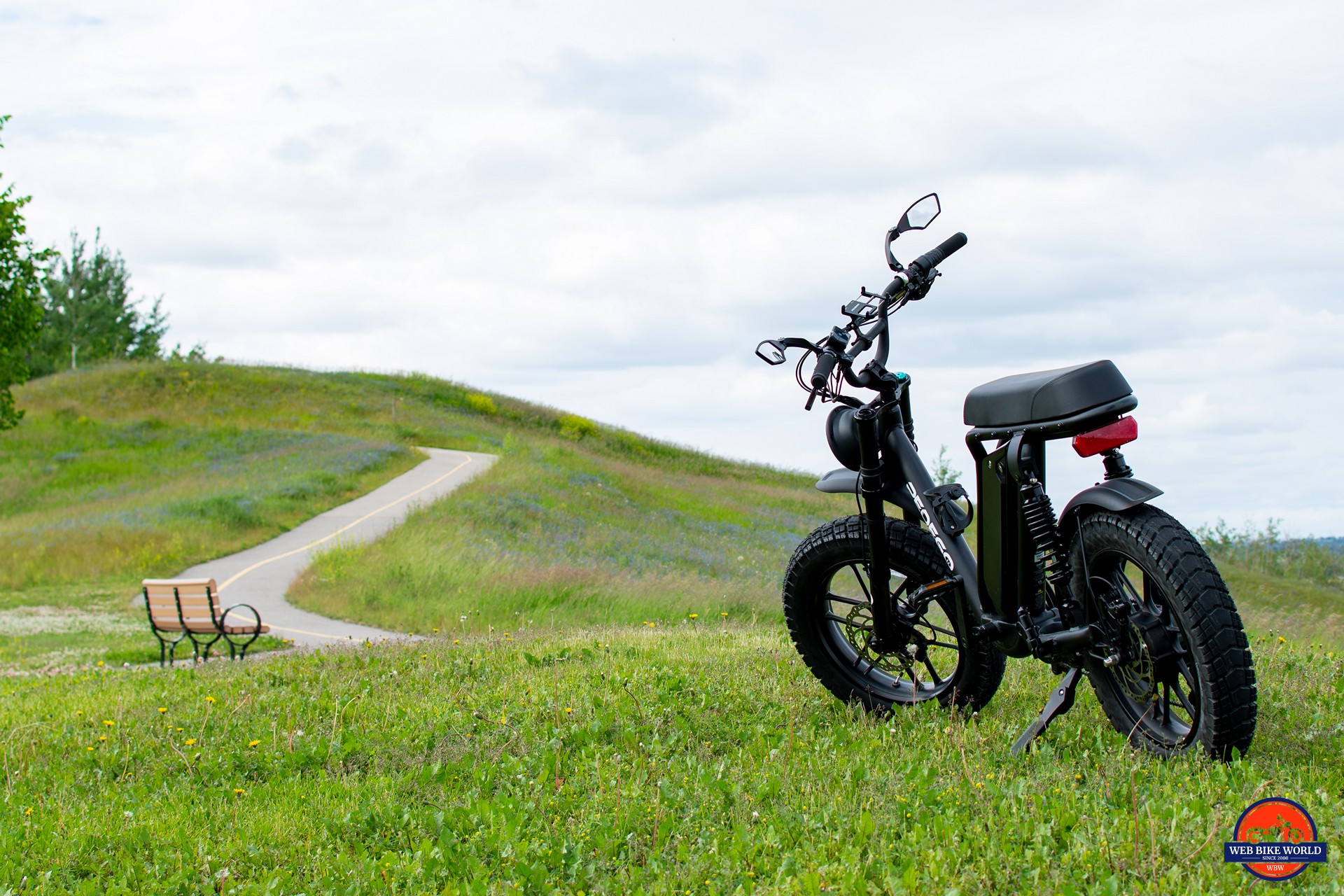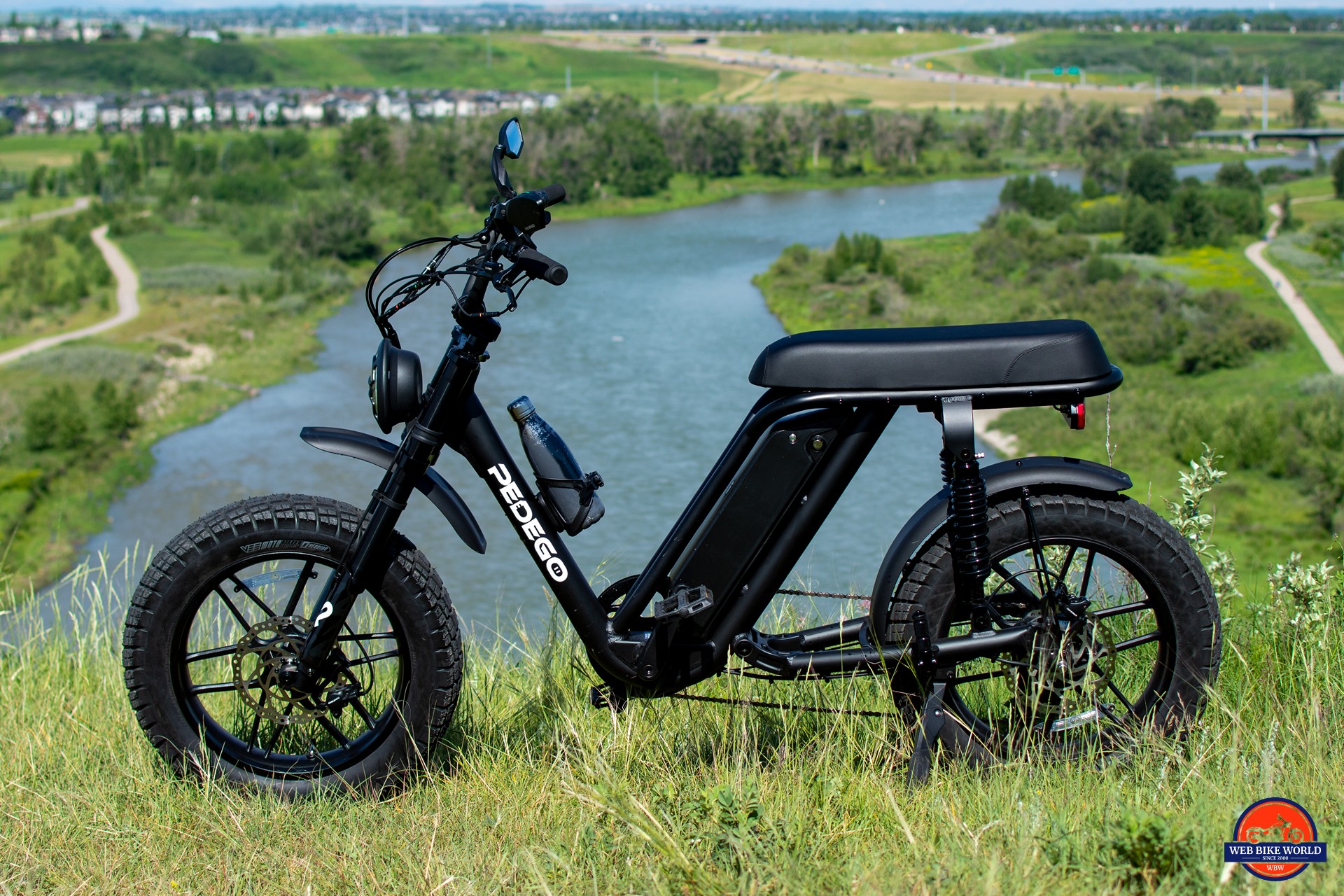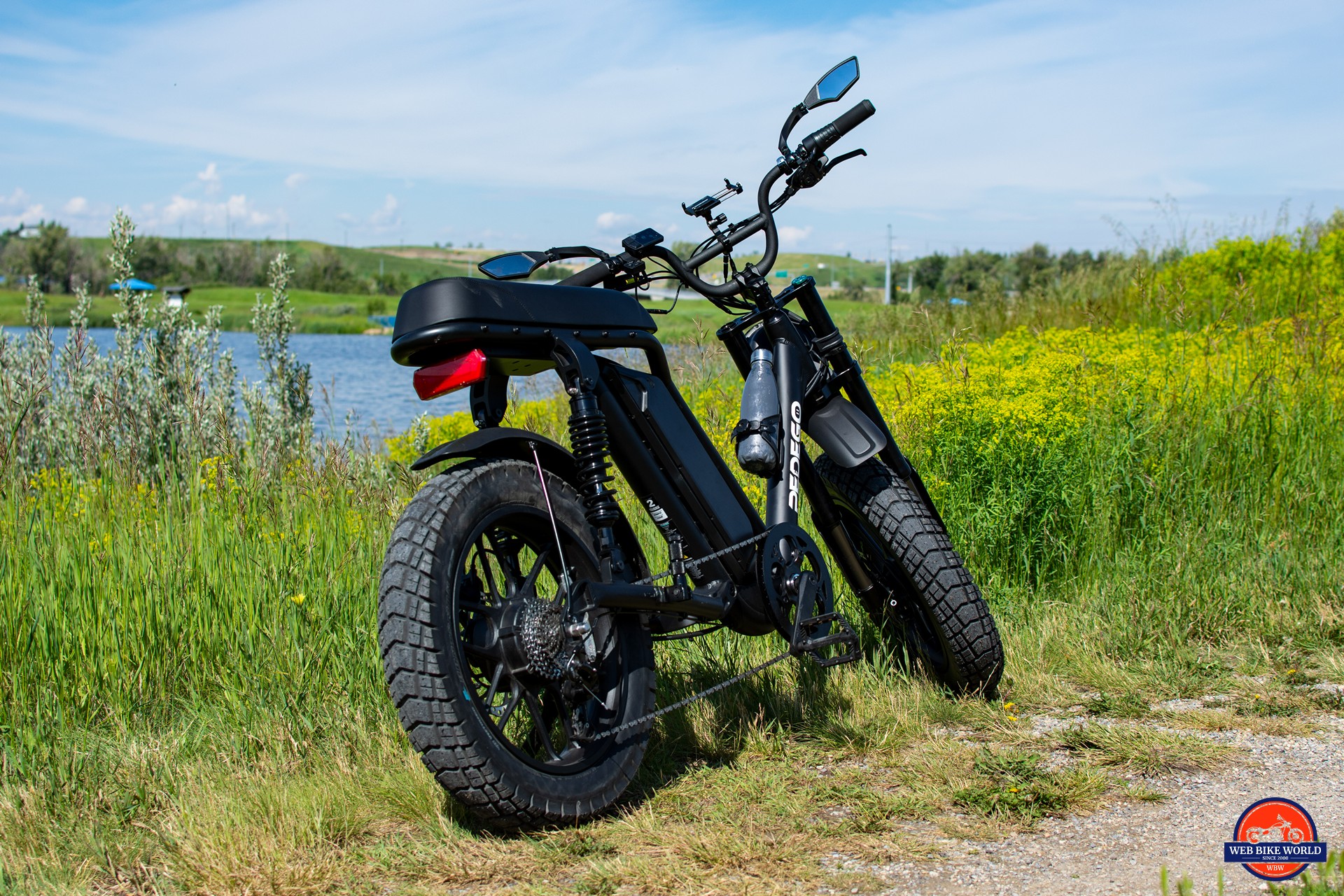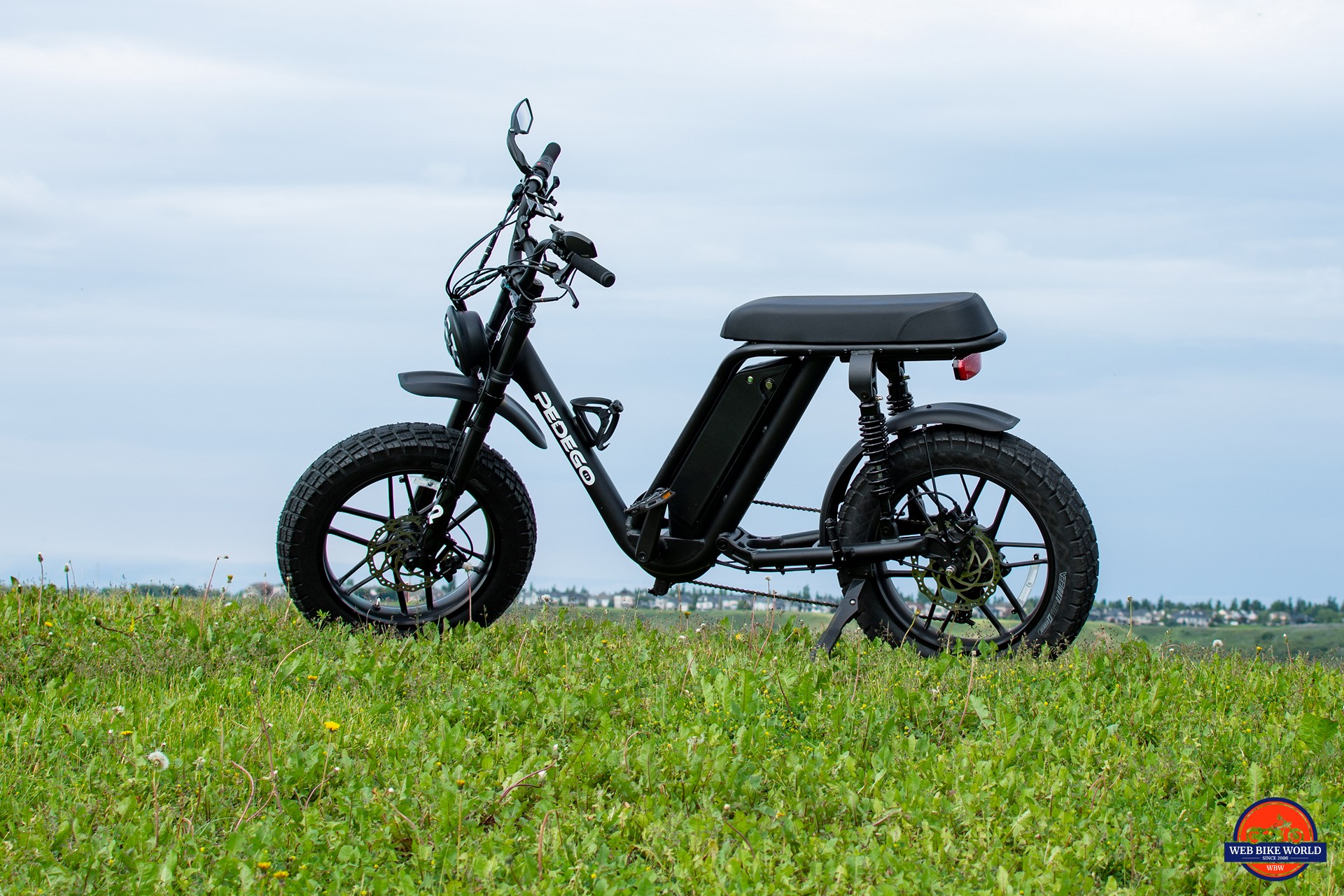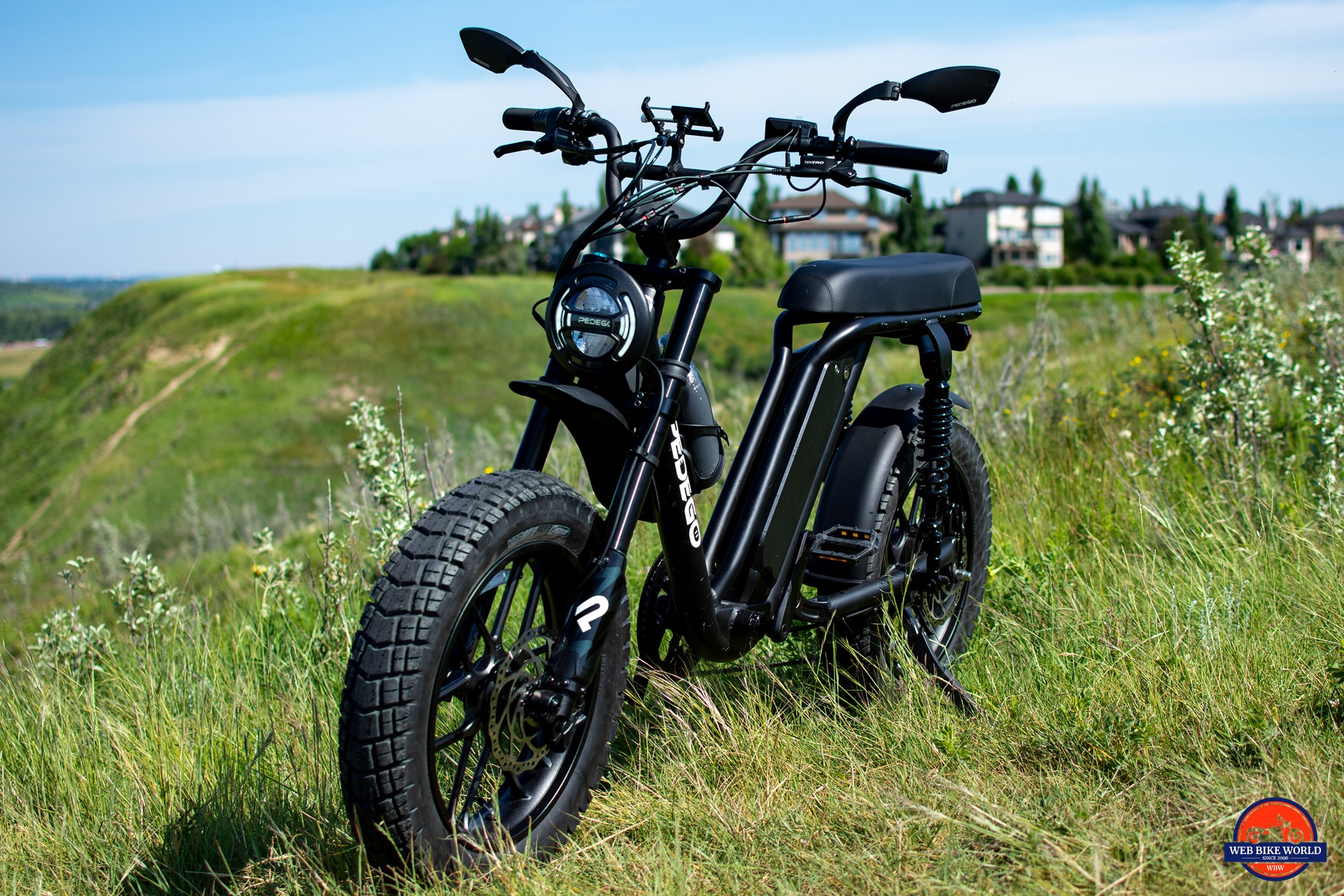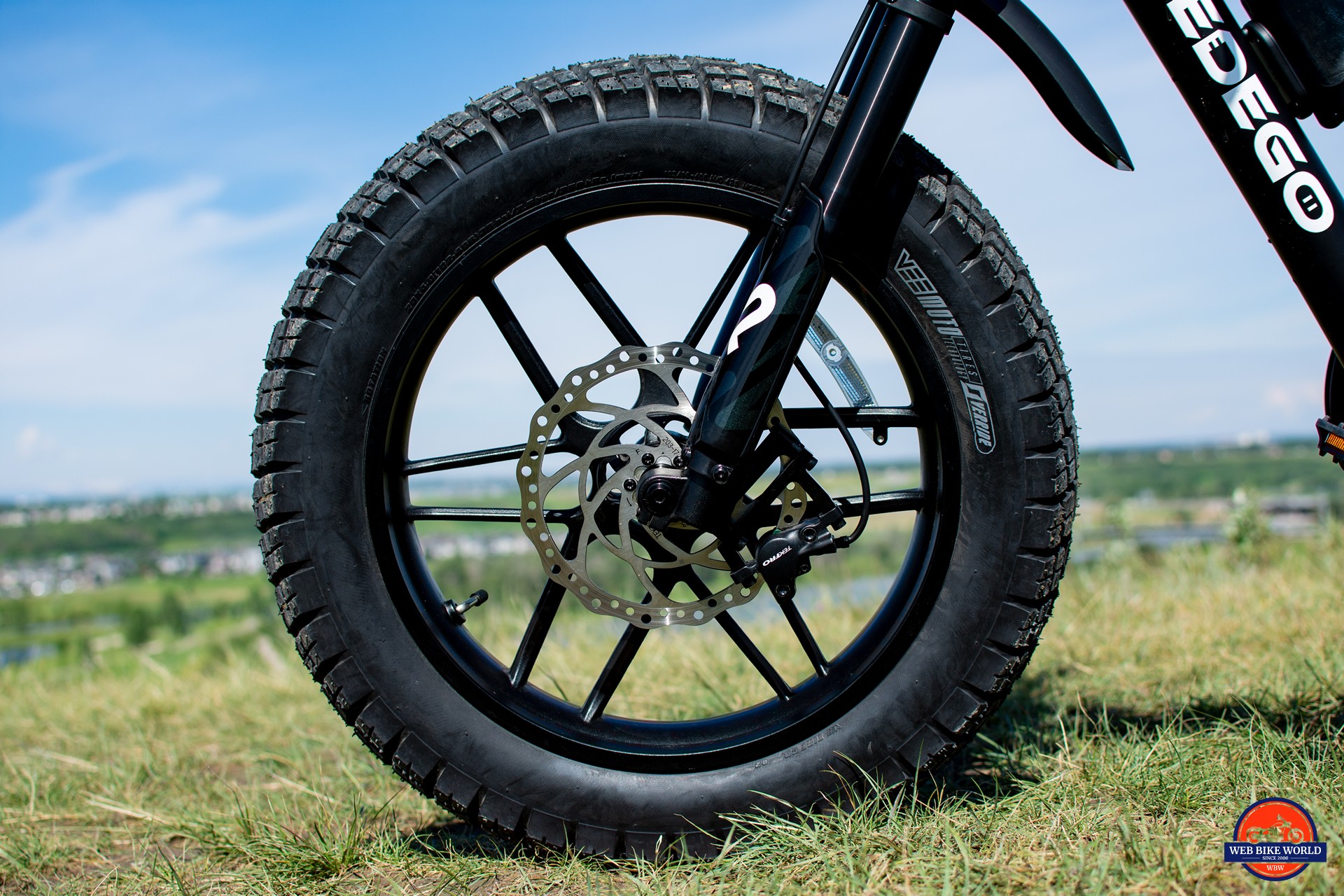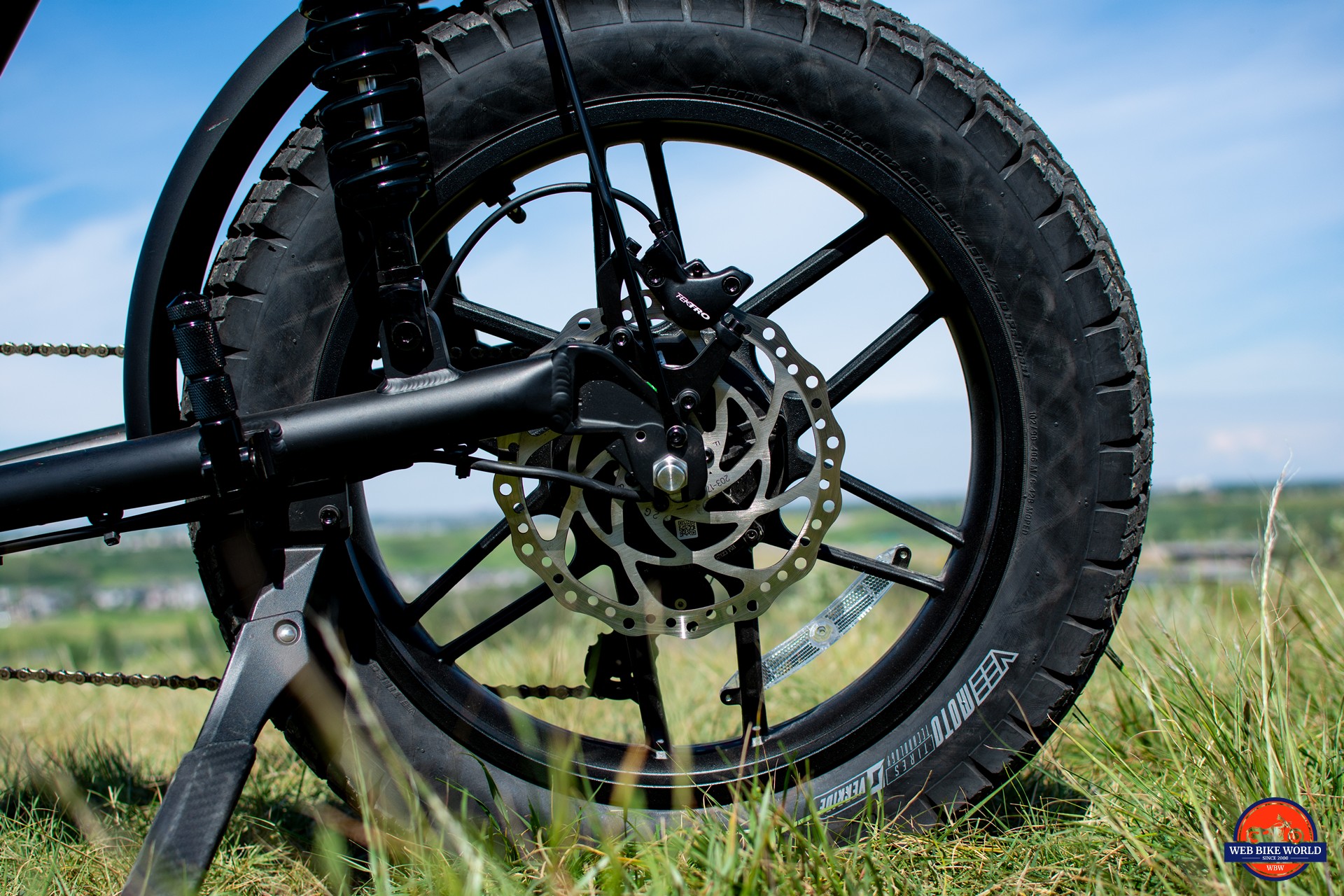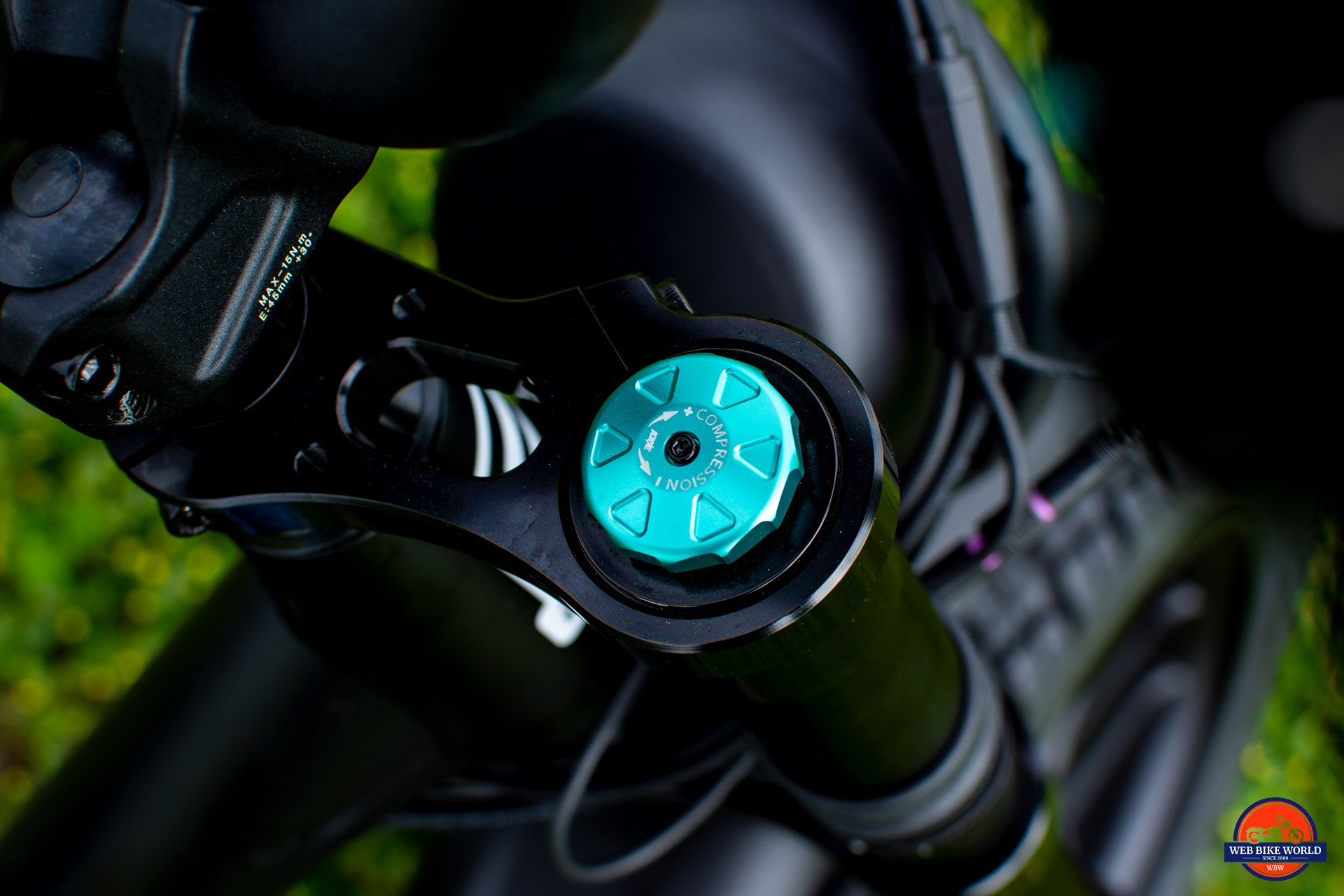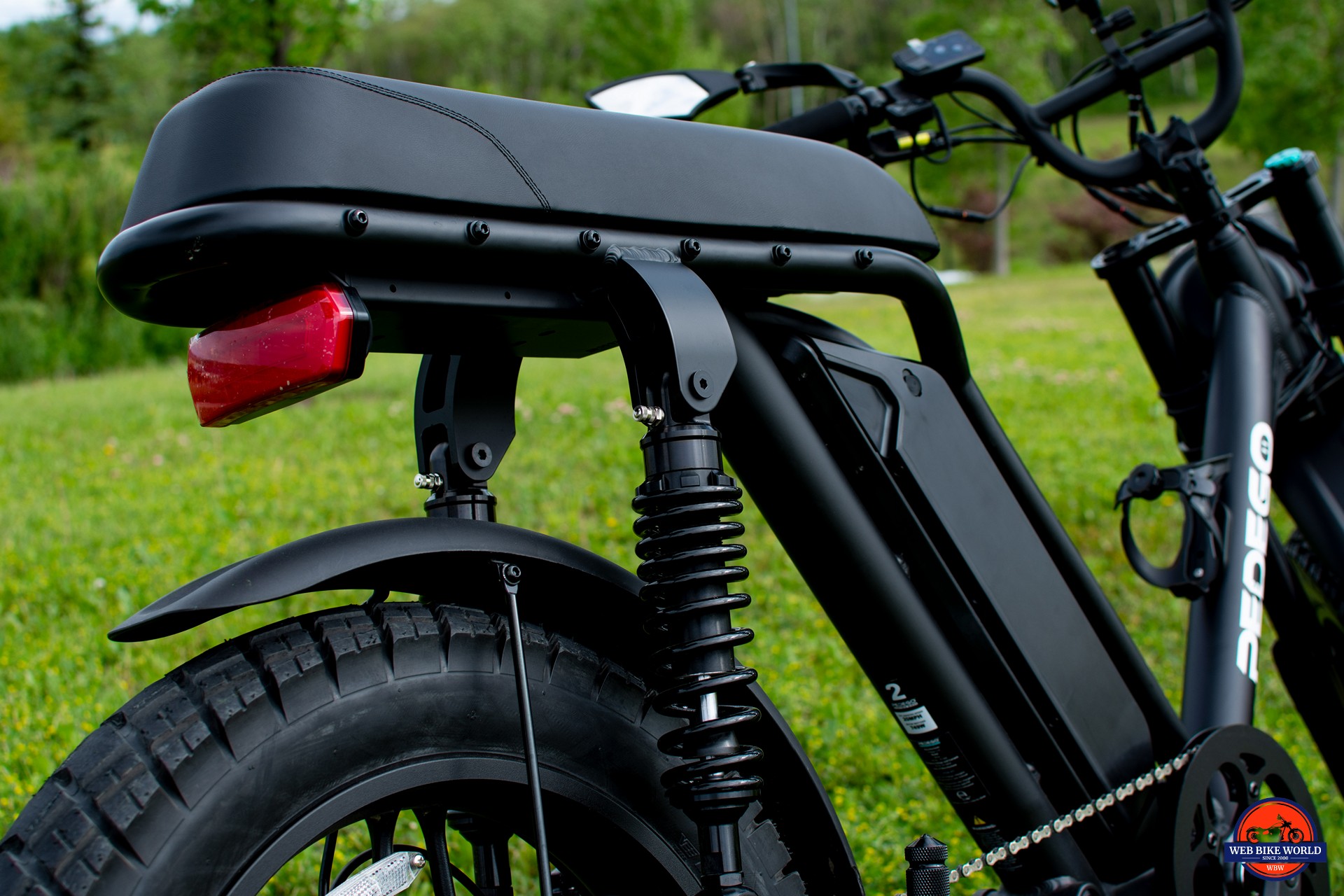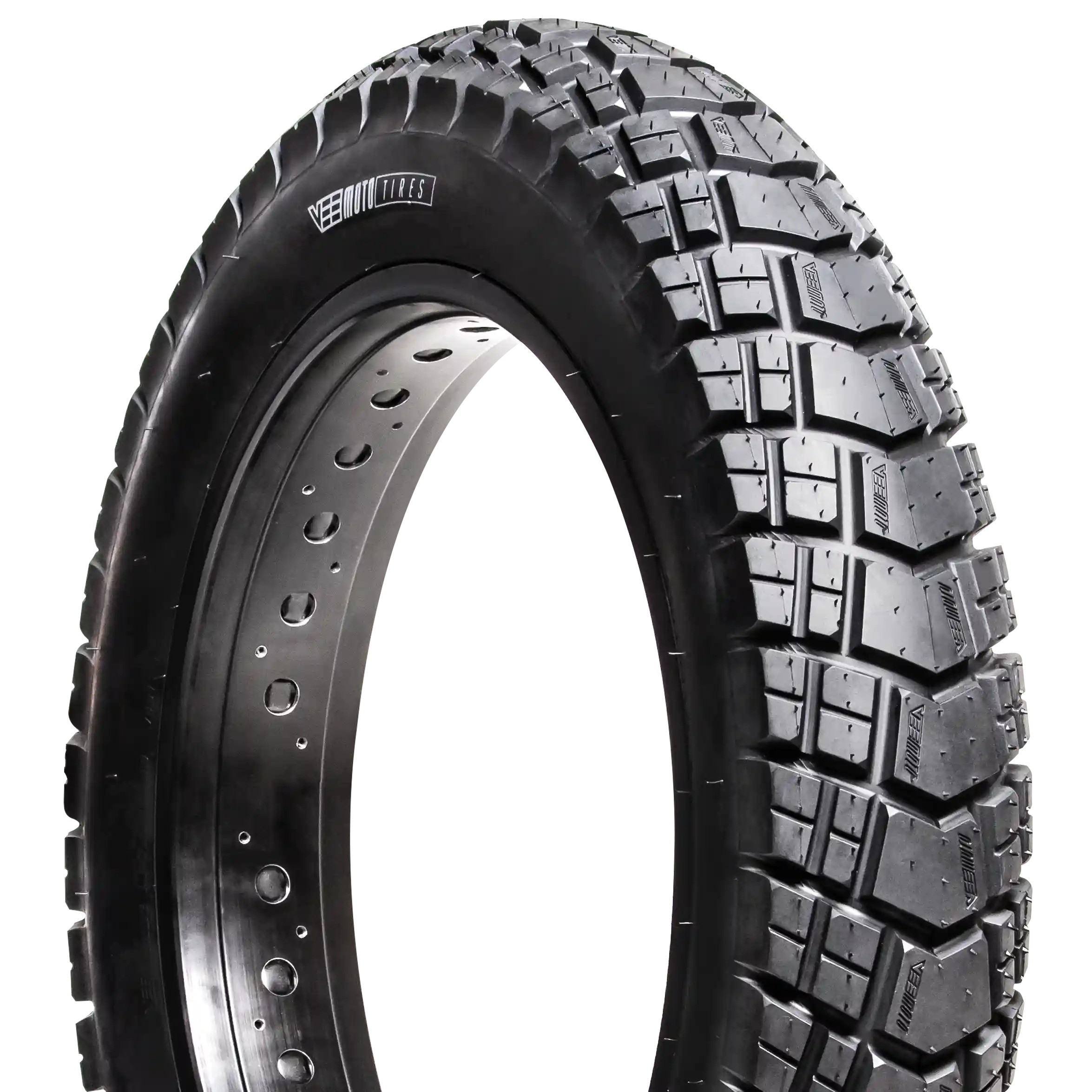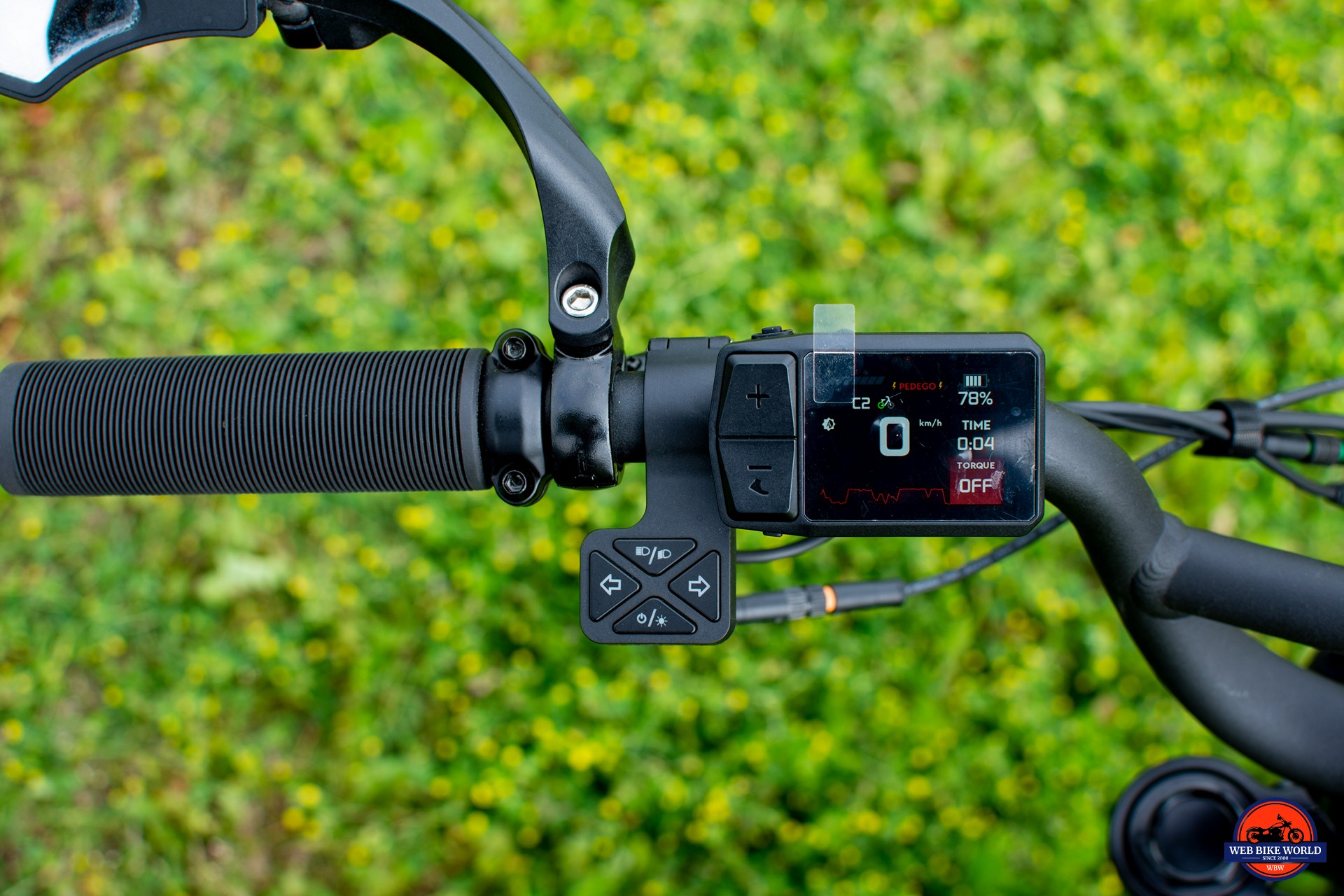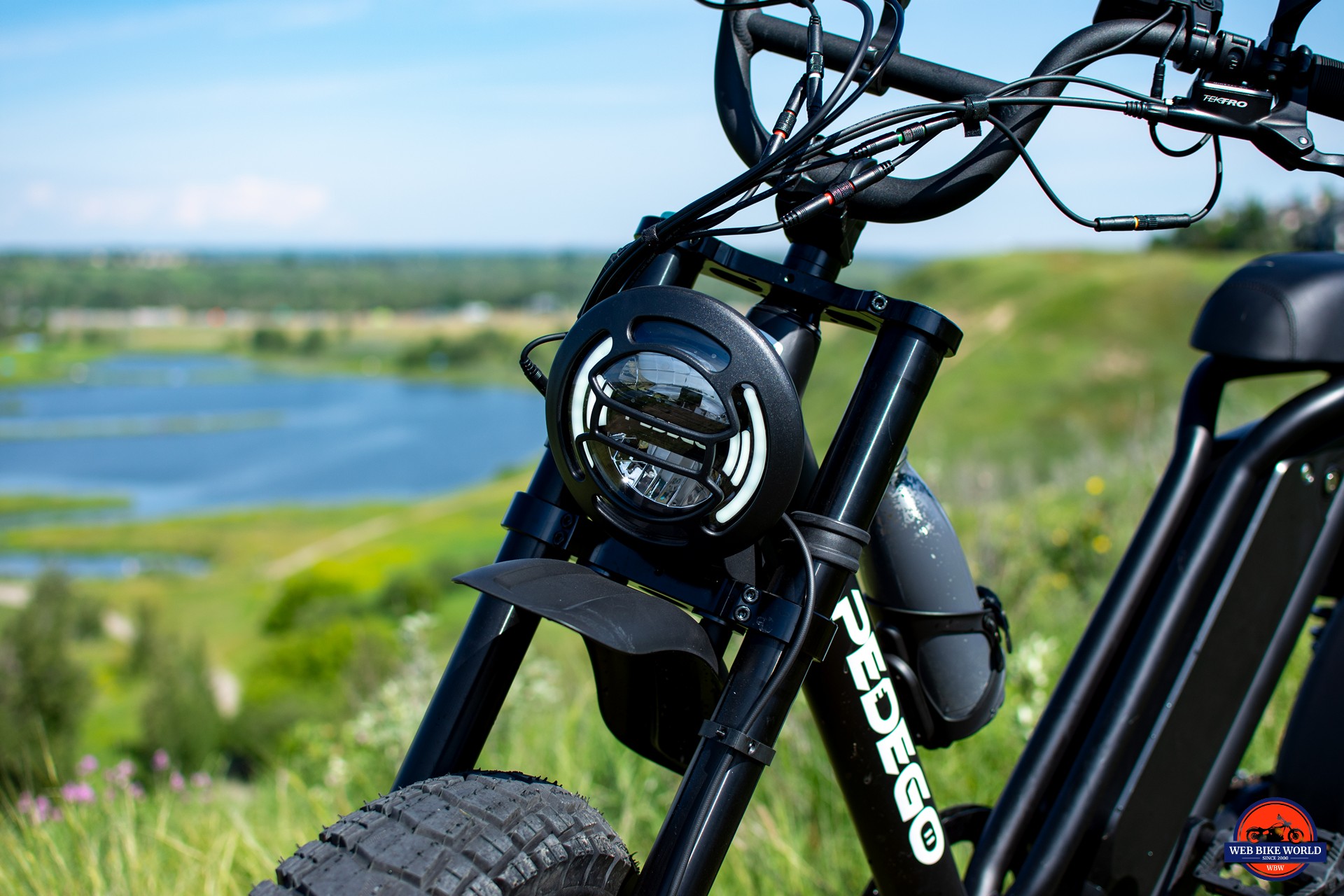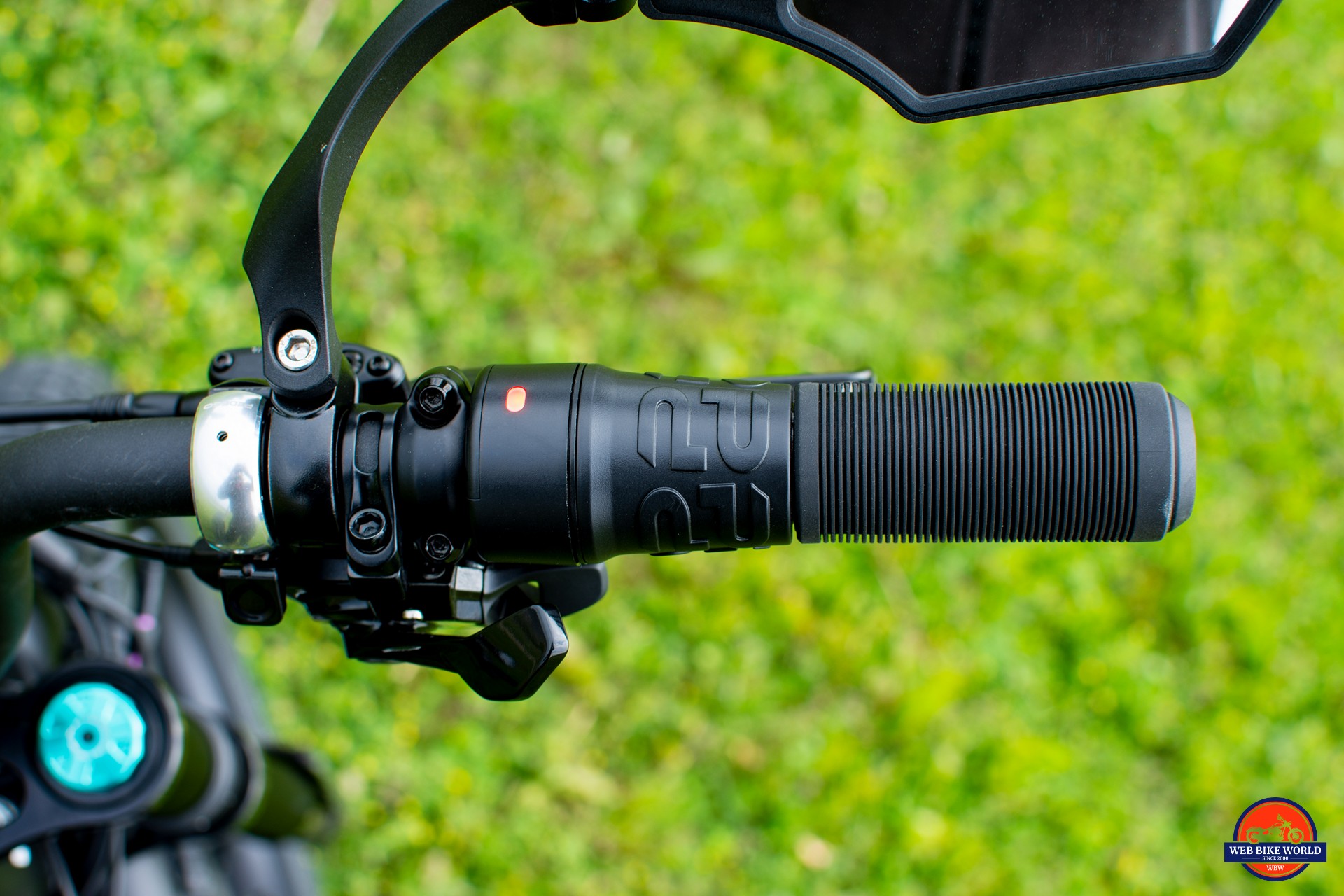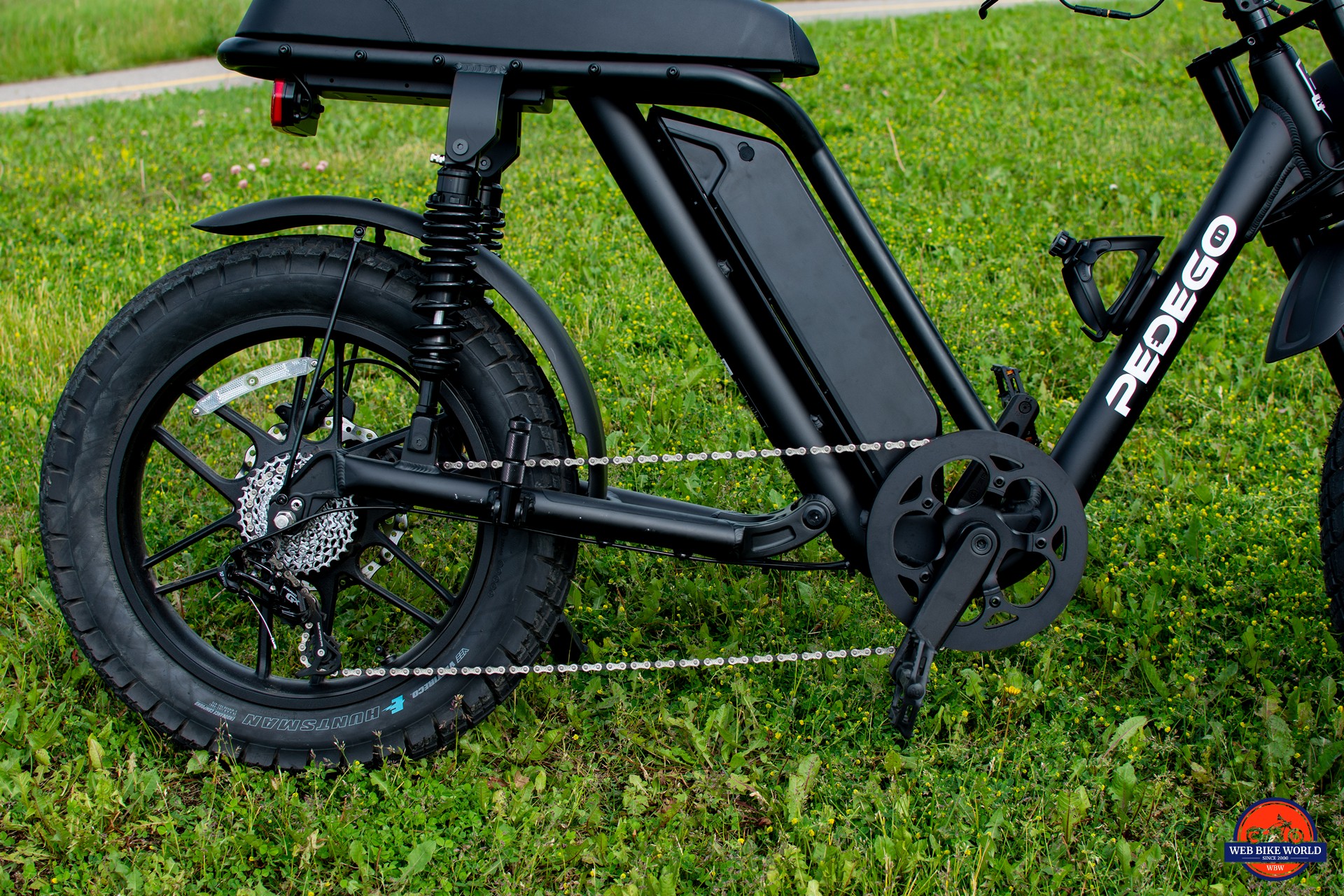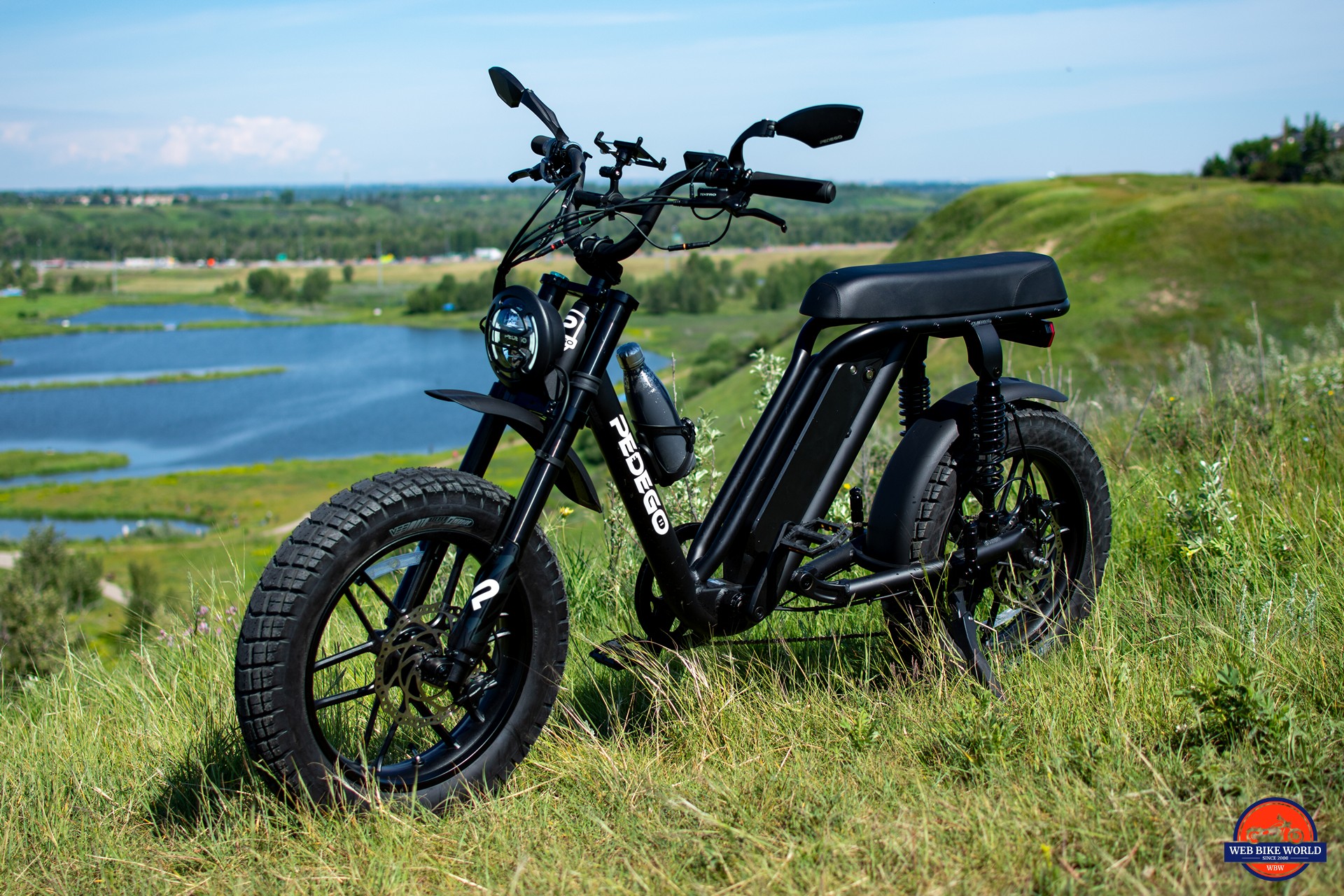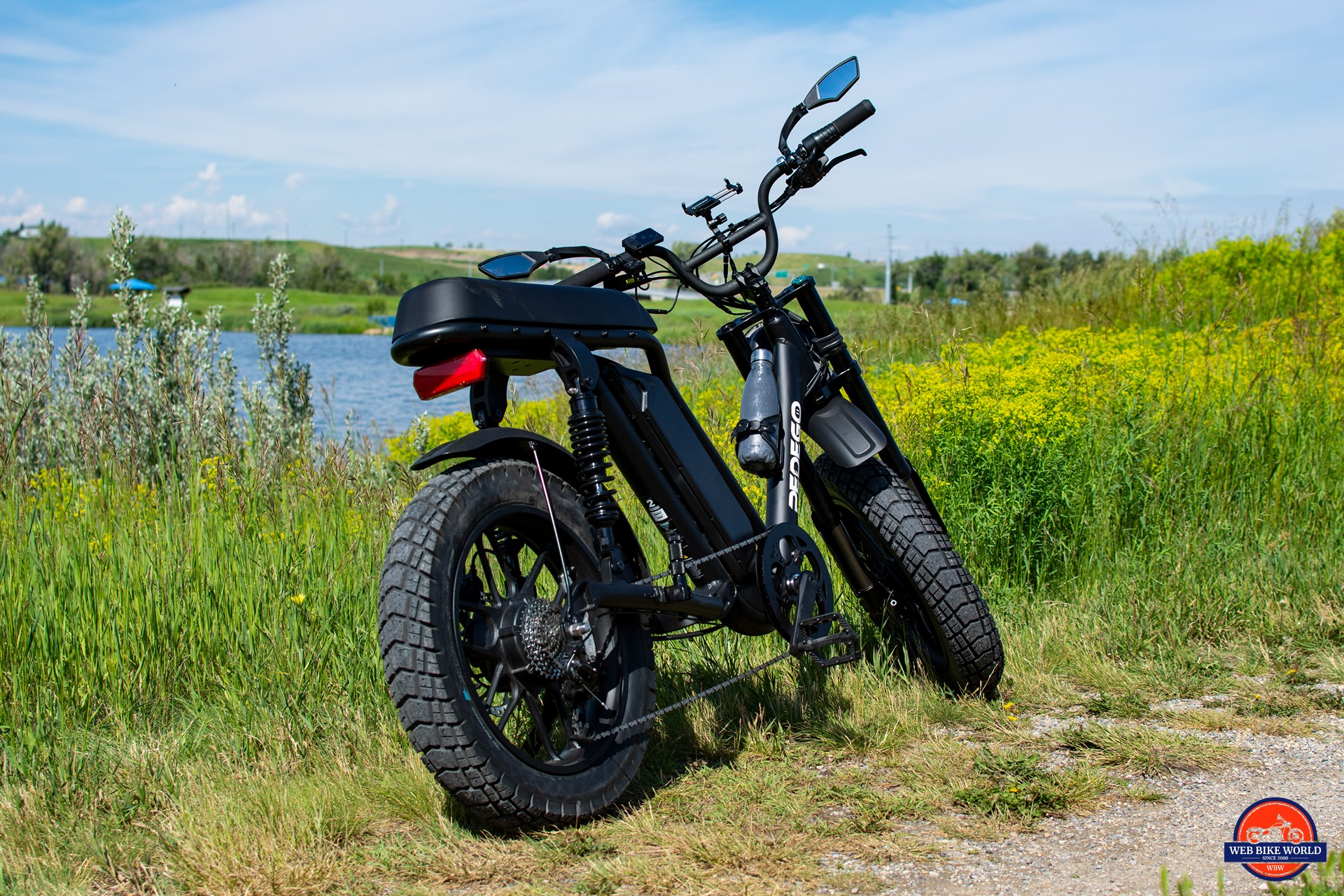The Pedego Moto is a premium moped-style ebike, packed with convenience features and build elements that owners will appreciate – including rear pegs for a passenger.
With a 400-lb weight capacity and a beefy 19.2 Ah battery, the Moto might actually fit you and a companion, assuming you both are on the lighter side. For parents with kids, this might be a real beauty of a bike. Well, it’s more of a moped than a bike, but I digress.
After riding the Moto for two weeks, here are my five takeaways:
- The Pedego Moto is best suited for paved or groomed trail systems, but it is competent off-road in situations where aggressive pedaling isn’t required. The inverted dual-crown front fork and rear air-adjustable shocks provide a cushy and compliant ride. It almost feels like the Moto floats over singletracks and road imperfections.
- At 89 lbs, the Moto is the heaviest bike I’ve ever ridden (even more than the 88 lb Himiway Cobra Pro I reviewed last year). Unlike the Cobra Pro, which sports a 1500-watt mid-drive, the Moto’s 750-watt rear hub motor sometimes feels anemic, especially when climbing hills on throttle only. 90 lbs of bike is a lot for a hub motor to move.
- The big 203 mm brake rotors and Tektro hydraulic brakes do a great job of stopping the Moto. This is a good braking setup that is adequate for the Moto’s needs.
- The use of a 10-speed SRAM GX groupset is interesting given that the Moto isn’t the best bike to pedal. Using a 7-speed groupset and investing in a more powerful motor would have given the Moto more utility for its intended use case, but it’s hardly bad that Pedego equipped the Moto with a nice groupset.
- The selectable pedal assist system allows you to choose “Cruise” (cadence sensing), torque, or throttle alone. The Moto will comfortably throttle just about anywhere you want it to go in an urban environment, though it will struggle on steeper or longer hills. The Moto is the first bike I’ve ridden that lets you swap between cadence and torque-sensing pedal assist.
Sound interesting? Read on for more details on this heavy-hitting cruiser.
Words & Photography: Cameron Martel
With thanks to Pedego Calgary for facilitating the delivery of this demo model. All reviews are subject to our review policies. Products are scored based on our hands-on experiences with it. To date, I have hands-on reviewed more than 30 ebikes and currently have five in my garage.
2024 Pedego Moto Specifications
- MSRP: $3,995 USD / $5,395 CAD
- Where to Buy: Pedego website (Canada)
- Warranty: 5-year warranty on the bike and battery
- Top Speed: 28 mph / 45 kph
- eBike Class: Class 2 out of the box, class 3 unlockable
- Range: Claimed 75 miles / 115 km (wBW estimated 30 miles / 48 km)
- Bike Weight: 89 lbs / 40 kg (including battery)
- Weight capacity: 400 lbs (182 kg)
- Motor: 750-watt rear hub
- Torque: Estimated 85 nm
- PAS: Torque or cadence-sensing, 5 -levels
- Brakes: Tektro hydraulic brakes with 203 mm rotors
- Gearing: SRAM GX 10-speed
- Battery: 48V 19.2 Ah (922 Wh)
- Wheels & Tires: 20” x 4” cast aluminum wheels with Veetireco Huntsman tires
- Other: Headlight, powered taillight, turn signals, passenger pegs, full suspension
Getting to Know the 2024 Pedego Moto
I took the view that if you’re shopping the Moto, you’re already aware of the cycling downsides of this frame type (namely, that it’s awkward to pedal like a bike). In its class, the Moto is one of the pricier options, but it comes with upside that prospective owners might value, namely:
- UL-certified battery made with brand-name LG, Panasonic, or Samsung cells (no random garage fires for me, thank you very much)
- A national dealer network to support Pedego’s industry-leading 5-year warranty.
- Cast aluminum wheels with 20×4” Veetireco Huntsman tires
- A big and bright LED headlight, a powered rear brake light, and turn signals
- Selectable pedal assist options
- Full suspension with rear air-adjustable shocks
The first thing I noticed when I sat on the Moto is that, more than any other moped or motorcycle-inspired ebike I’ve ridden (and the list of those gets longer every year), the riding position on the Moto is more cruiser motorcycle than bicycle.
The Moto’s riding dynamics are both interesting and configurable, as the Moto allows you to select between cadence sensing and torque sensing pedal assist. This is a brilliant solution to the age-old compromise that ebikes force on you: do you want to “cruise” as you commute, or do you want the bike to amplify your output? Well, why not both?
Given the form factor, I did most of my riding with the Moto in “cruise” mode. The cadence sensing assist – Pedego’s proprietary PedalSense – is sensitive, responsive, and easy to ride with. It allows you to ride the Moto like a proper cruiser, putting in a bit less effort but enjoying the ride all the same.
The torque mode, though, is interesting because it really dials in the responsiveness of the drivetrain. It’s one of the better-configured torque sensors I’ve ridden with, and I’ve had my hands on nearly two dozen torque-equipped ebikes at this point.
But the form factor isn’t conducive for effective riding, meaning that you’ll primarily be scooting around via the throttle.
Depending on your view, this is either a feature or a bug. From my perspective, it makes the Moto’s intended use case very clear: here is the throttle, why not give it a twist?
The Moto’s tires are more on-road than off, but I can tell you from experience that it is happy to dig in the dirt if you ask it to. Just remember that the Moto isn’t the best equipped if you need to pedal your butt back out again…
Given the Moto’s more laid-back riding position, with the crank slightly in front of your hips when you’re sitting, I felt that I was pushing the pedals forward as much as I was pushing them down. Due to the long banana seat and where the battery sits in the frame, I found that my thighs rubbed the seat support bars when I pedaled.
Neither quality is ideal for aggressive pedaling, so I decided to ride it as its designers intended and made liberal use of the throttle.
2024 Pedego Moto Build Quality & Components
The Pedego Moto is a confusing combination of components, and not because any of them are particularly bad, but because they are actually pretty good and strapped to a form factor that doesn’t effectively reward their capability.
Suspension Fork, Tires, & Brakes
Pedego has opted for a motorcycle-esque cast aluminum wheelset with 20×4” tires. The tire size and width is fairly common, but the cast aluminum wheel is less so. Clearly inspired by its bigger brothers, the Moto is indeed aptly named.
When I got down low with my camera, the first thing I noticed was the big 203 mm rotors. Thank you, Pedego—you get it.
When a bike weighs around 30 lbs, like my Orbea Occam H30 “acoustic” bike, 180 mm rotors are quite monstrous and do a great job stopping the bike. But when a bike is 80 or 90 lbs, I’m very glad to see 203 mm rotors installed.
The larger rotors will give additional “bite,” dissipate heat more effectively, and be less susceptible to brake fade. Paired with Tektro hydraulic 2-piston calipers, the Moto is eager to come to a halt.
The front fork is an inverted dual-crown setup, like the setup on the HeyBike Brawn I reviewed last year and the Himiway C5 I reviewed earlier this year (in fact, I think the Moto uses the same fork as the C5).
As with both of these bikes, the Moto suffers from a reduced turning radius as a result. This is most noticeable in the garage when you’re moving the bike around and isn’t much of a problem when riding unless you’re taking the Moto down intricate technical trails that, frankly, it has no business going down.
The front coil suspension provides 140 mm of travel and has adjustable compression and preload. It can be easily configured to your preferred comfort.
The rear hydraulic suspension has an air-adjustable preload, allowing you to stiffen or loosen it as needed. You’ll need a hand pump to do this, but it doesn’t take long to dial it in. If you regularly ride with passengers or are a heavier rider, you’ll be glad to add some firmness to the rear.
I was surprised at how much bite the Veetireco Hunstmans have relative to how much noise they make. I (wrongly) assumed that the aggressive all-terrain tread pattern would be pretty loud on pavement, but that’s not the case. In fact, the Moto scoots along as quietly as any bike I’ve ever tested.
While the tires didn’t give me the confidence to fling the Moto down a downhill trail, they did give me the confidence to run nearby singletracks… and I had a blast. Between the riding position, frame style, and suspension, the Moto allowed me to comfortably trek the trails with minimal jittering and bouncing.
Display & Handlebars
I opted to leave the plastic cover on the display since this is a demo bike, which causes some reflections in the photo that aren’t really there in real life.
Pedego uses a small full-color LCD display on the left bars instead of the more traditional “screen in center” setup used by most brands. There’s nothing wrong with this, and since the display is plenty legible and can get quite bright, I didn’t find any impairments in viewing it, either.
You configure the bike through this display and use it to interact with the settings menu:
- To turn the bike on, hold the small button on top of the display (above the + button) for a few seconds.
- Hold the bottom button (underneath the – bottom) for a few seconds to access the menu
- Use the + / – buttons to navigate through the menu, and press the bottom button to select the options you want to change. Once selected, use the + / – buttons to modify the settings
- The display is where you change pedal assist settings from cadence (“cruise”) to torque and adjust the level of pedal assist power (mild, moderate, “Pedego”). I kept the Moto in “Pedego” mode, as that provides maximum power and responsiveness from the PAS system and throttle.
Notably different on the Moto is the inclusion of turn signals, which make an audible “BEEP” when used so you don’t forget to turn them off. The HeyBike Tyson I reviewed last year also has turn signals, which make for a nice visibility improvement, but I find that I don’t think to use them when I’m riding. That might just be me, though, as I don’t tend to ride in crowded urban environments; I can see the turn signals adding value if you’re commuting downtown with the bike, for example.
Also on the left bars, above the turn signals, is the headlight switch. Pedego equipped the Moto with a huge LED headlight that is very suitable for dawn, dusk, or night riding. It also has low/high beams, which isn’t a first for me on an ebike but is uncommon. And it’s plenty bright, by the way. You’ll be just fine riding at night.
The right bars feature your shifting mechanism, a bell, and the half-twist throttle. Twist throttles aren’t my favorite, but this one works as well as you’d expect it to. Pedego has equipped the Moto with an LED indicator on the throttle, letting you know when it’s active or not.
- Red means the throttle is inactive, which is the case when you have pedal assist set to 0
- Green means it’s active, which is the case when you have pedal assist set in settings 1-5 or have the Moto in throttle-only mode
- Blue means it is in walk mode, which is a very effective value-add that makes walking the Moto up a hill nice and easy
The mirrors on this specific bike are aftermarket and installed by the dealer.
Groupset
The SRAM GX groupset is a solid mid-level groupset and is equally at home on an enduro or downhill eMTB as it is on the Moto. It’s an odd inclusion, though, since the Moto is not ideal for actually pedaling. I question how many riders will make effective use of the 10-speed groupset.
Earlier in this review, I mentioned that I’d have rathered that they used a more entry-level groupset, like a Shimano Tourney or Acera, and placed extra emphasis (and budget) on the motor. Given that pedal ergonomics, it’s clear that most people will make liberal use of the throttle vs. pedal aggressively.
That behavior is a feature, not a bug, by the way. It’s part and parcel with this frame – something I commented on when I reviewed the Michael Blast Outsider 4 and Outsider 5, and frankly, every other moped-style ebike I’ve ridden.
Buuuuuuut, its inclusion on a premium-priced ebike also makes sense since spec sheet shoppers might balk at seeing entry-level components on a non-entry-level bike.
The Elephant in the Room: Value for Money
If you’re buying the Moto, you’re choosing to invest in one of the most expensive versions of the classic moped ebike. This isn’t a good or a bad thing; it is one of those “it is what it is” things.
But the market is filled with Moto lookalikes, and riders are spoiled for choice regarding which one they opt to invest in.
Chinese ODM brands, in particular, love to produce models like this, and they often cost less than half of what Pedego is asking for the Moto. While few offer all the same amenities—full suspension, 19.2 Ah battery, torque sensing, and rear footpegs—many offer a similar riding experience for much less money.
- The Juiced Scrambler X2 has a more powerful motor, but with a smaller battery and cadence pedal assist and a hardtail frame.
- The Michael Blast Outsider comes in at $2,799 for the 750-watt version, with cadence sensing, a 14.5 Ah battery, and a hardtail frame.
- The Himiway C5, Escape Pro, and Big Dog all cost well under half of the Moto’s asking price. They feature full suspension frames with comparable batteries. The C5 and Big Dog also have hydraulic brakes, whereas the Escape Pro has rocking mechanicals.
None of the above comparisons are identical to the Moto – all but the C5 use cadence sensors, most are hardtails, and most have smaller batteries. Those are compromises you make by comparison, but when the bikes cost less than half the price, it’s not unreasonable to think that many people will opt to go that route.
If anything, this comparison hammers home what the community – and Pedego – has been saying about the brand: you don’t buy a Pedego because it’s the cheapest, you buy it because of all the other things that add value to the ownership experience.
Things like a national dealer network to support the 5-year warranty, for example, or the extra attention paid to the frame and components during assembly that results in tangibly better build quality compared to its peers.
The Pedego Moto Might Be the Top Tier Moped-Style eBike You’ve Been Waiting For
Ultimately, the Pedego Moto is indeed a capable moped-style ebike. It’s built better than just about every other one I’ve ridden or seen in the wild, and is not lacking for creature comforts. If you’re shopping a moped ebike and are aware of the downsides with respect to pedaling, the Moto is one of the best options out there for you.
There are two downsides that you should think on before buying:
- The price. $4,000 is a lot of money for a moped ebike, and it might be worth looking at less expensive options if the price gives you pause.
- The weight. 89 lbs is a lot of bike to move, and about 20-30 lbs heavier than many competing bikes. If you have mobility issues, back problems, etc. I recommend getting to a Pedego store and trying it for yourself vs. buying sight unseen. I have an L5/S1 herniation and C4/C4/C5 degenerative disc disease and didn’t have much trouble moving the bike around, but I definitely did not love lifting it.
That said, there’s a lot here to like:
- The brand. Pedego is one of the only dedicated ebike manufacturers with a national dealership network in both the United States and Canada. Advocates for the brand are quick to point out the responsiveness and capability of Pedego’s customer service, and that has been my experience as well.
- The warranty. Pedego offers a 5-year “no excuses” warranty, though it comes with a few stipulations, the most pressing being that you have your Moto tuned up at 100 miles by a dealer, and then serviced annually by a dealer. I always have my bikes serviced in the spring and again in later summer and I think everyone should, as well. It’s worth noting the stipulations when buying, especially if the warranty is a major motivating factor for you.
- Build quality. Clean welds, good quality components, and a very “solid” feeling all contribute to the feeling of good build quality. The weight also helps here, too, as the bike doesn’t feel flimsy and there is minimal frame wobble (which is something that step-thru designs often suffer from).
- Dual passenger capability and a heavy weight capacity. The Moto is the only ebike I’ve ridden or seen in person that comes with foot pegs for passengers. Your kids will love riding with you on this!
- Throttle-on riding dynamics. The Moto sits you in a relaxed, laid back “cruiser” position that is comfortable to throttle around with, but less so when pedaling. If your plan is to throttle away, you’re going to love the riding position.
- Flexibility. Multiple pedal assist modes and two different pedal assist sensing options make it easy for you to tailor your riding experience to suit your preference.
If you’ve got $4,000 to spend and want one of the most capable moped-style ebikes on the market, the Moto has got your ticket.
2024 Pedego Moto Review Summary
Review Summary
If you’re looking for a moped-style ebike that is suitable for the urban environment, the Pedego Moto is a good option. Priced at the premium end of the segment, Pedego didn’t cut any corners on the Moto. While it lacks somewhat in the motor department, it never failed to get me where I wanted it to take me.
Pros
48V 19.2 Ah battery provides a claimed 75-mile range (I estimate a real-world 25 – 30 miles of range)
85 Nm of torque from its 750 watt rear hub motor
Comes equipped with passenger foot pegs
Front and rear air suspension with fat 4” wide tires
Good finishing on the frame, crank housing, and components
Cons
Heavy… 89 lbs!
Rear hub motor could use more power
Uncomfortable to pedal
Pricey


